Below is the transcript (with minor adjustments) from my keynote at the Calgary ConnectEd Conference. I have been encouraged to post it and so it is here.
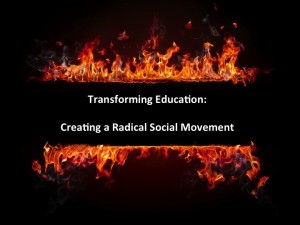 Good evening….It is a privilege to speak here tonight and to actually be in the room with so many people that are already doing this work. There are 29 educators from my own district here that our deeply immersed in engaging in this transformation. I am going to share with you a bit of our story. I hope you find it helpful.
Good evening….It is a privilege to speak here tonight and to actually be in the room with so many people that are already doing this work. There are 29 educators from my own district here that our deeply immersed in engaging in this transformation. I am going to share with you a bit of our story. I hope you find it helpful.
How do we transform education? How do we create a radical social movement? Where do I begin—I think I need to tell you a little bit about what I believe and why this is important to me.
My job is Director of Instruction. I look after K-12 Curriculum & Instruction in a district of 70,000 students. My portfolio includes everything from the Intensive Fine Arts Schools, Numeracy, PE, Science, Technology, Social Studies, Learning Resources to Aboriginal Education and more. My primary portfolio responsibility, however, is curriculum transformation. But I can tell you that my personal commitment to transforming curriculum goes beyond the formal designation of my job.
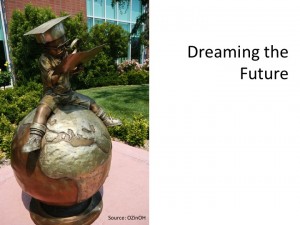 Because, for me, what I really care about is public education. I care about being relevant. I care about having the best system possible. And I care about my four boys in grades 1, 4, 9 and 11. They are the digital learners. I want what’s best for them.
Because, for me, what I really care about is public education. I care about being relevant. I care about having the best system possible. And I care about my four boys in grades 1, 4, 9 and 11. They are the digital learners. I want what’s best for them.
It bothers me as a parent when I see my own children, reasonably good kids, disengaged from their school. It bothers me when they ask me if I will homeschool them. It bothers me when they don’t have authentic voice, choice and the opportunity to pursue their own interests.
I want to tell you about what happened to my son in grade 8. When I arrived home from work one day, my luddite husband turned to him and said, “Have you told your mother yet?” My son is bright, really bright, but is often bored with school. He also doesn’t have a lot of friends. He was the child that didn’t often get invited to the birthday parties in elementary school. And, yes, that is enough to break a mother’s heart. He got along well adults, his teachers and coaches, they all loved him but there was a misfit with his peers.
For years, he has kept the same type of journal log as a record of his reading. It has been a requirement from his teachers. He lands in grade 8 and this time he asks his teacher if he can do it electronically and create a blog instead. The answer: no. The reason: she wants a coil bound copy to take home to read and mark instead. Do you think my son was very motivated to keep the paper log she required? Do you think that created the space for him to do his best work? How did he feel about his journal after that?
She is a great teacher and I love her dearly. She has taken care of my son when he first went to that high school. The teacher’s own practice, however, had not yet been touched by the needs of digital learners. That is not really her fault; it is actually ours as educational leaders for not providing teachers with the opportunity to embrace the digital age.
I will tell you one other story about my oldest. My son loves drafting, he loves physics and he loves chemistry. Ever since he was little he drew elaborate pictures of cars because his dream is to design cars. In fact, his dream has been even more precise. He wants to design the world’s first hydrogen fuel cell car for the common man. Now I ask you, where has he been able to pursue this passion in his education? Tell me where has he been able to dive in deeply to study this topic? Where has been the multidisciplinary project that could have woven all those subjects together and wrapped them around him as the learner? Could he not have designed the car and perhaps even printed out a 3D proto-type? Why not?
We are doing a disservice to our children, and to my children, and all children, when we fail to design learning opportunities that are authentic, that honour their voice, their passions, their interests and engage them deeply in learning.
So my real mission, one that is deeply personal for me, is to transform education.
That would be my dream.
So how do we create the dream? How do we make that happen?
What do we know about people, what do we know about learning, what do we know about the future?
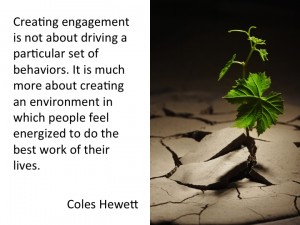 How can we create spaces where students are truly engaged? And, how can we create spaces where teachers are truly engaged in their own learning as well? I actually think the teacher comes first. When a teacher is passionately engaged in their learning, students are the beneficiaries.
How can we create spaces where students are truly engaged? And, how can we create spaces where teachers are truly engaged in their own learning as well? I actually think the teacher comes first. When a teacher is passionately engaged in their learning, students are the beneficiaries.
We created the Innovative Learning Designs project as our first initiative. Many Surrey teachers are involved in these projects. Guildford Park, Johnston Heights, Fraser Heights, Frank Hurt, George Vanier, Bear Creek and more. We invited interested teams to propose a project, designed by them but based on some guiding principles. We weren’t dictating from the central office how to teach, we were asking teachers to explore, experiment and play with their practice and with their organizational structures. We were providing teachers and schools with white space to be creative and write their own scripts. We acknowledged teachers as the professionals who know their craft the best.
We were overwhelmed with 67 school applications. People wanted in. We had crafted something to pull people into be innovative.
We knew we didn’t want to limit the learning to just those small pockets of innovation. There are many doorways and windows to innovation. It was important for us to create strategies and an action plan to light these fires and let them take off and spread across the district. I could tell you about more projects, key staff development events and our guiding principles, but I am not going to because actually it is more important that we talk about relationships.
Which brings me to my second point. When we talk about transforming education, we are doing it in the context of relationships.
Relationships are the oxygen of human development. We grow in community with others. This is true for students and well as us as professionals. We need each other to breathe and to grow. I need others, as do each of you, to act as our cheerleaders.
When you are being innovative sometimes others will think you are perhaps a bit crazy. Maybe a bit too far out there. People who are innovative are sometimes outsiders. I am an outsider. I am not part of the status quo and neither is the work that I do. For me, that sometimes means I hear things like, “We need to stop this innovative stuff and get back to our guiding principles” or “We need to get away from this invitation to be innovative,” “Why do I have to create a learning plan; just give me the hardware.” Or, “If you create centres of excellence, that makes other schools feel badly. You are creating haves and have nots.”” Or, “If you think that people from the field are going to rise up and change education you are sadly mistaken.”
Well, I actually do believe that. I do believe that it is the people in the field that will change education.
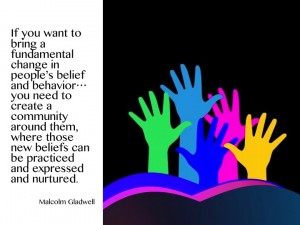 Malcolm Gladwell talks about the importance of community. This is truly related to the Theory of Diffusion. It is how we are spreading a fire for change. It is the people in this room that will change education. They will do it in a radical social movement that is starting in our backyard and your backyard.
Malcolm Gladwell talks about the importance of community. This is truly related to the Theory of Diffusion. It is how we are spreading a fire for change. It is the people in this room that will change education. They will do it in a radical social movement that is starting in our backyard and your backyard.
If we want to transform education, it really has to be done by the teachers in the field. We need people connected together, sharing their good work and nurturing each other. This is how we scale up pockets of innovation to a radical social movement.
If you think about it, this conference has been intentionally named: it is Connected Ed. It represents a community of people invested in transforming education. It is about the power of connection.
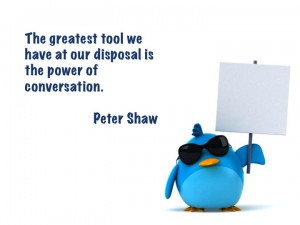 I have only been on social media for two years. I don’t know much about it. I do, however, know quite a bit about leadership and system change. I do know we are living in a new era. Social media has changed the nature of change, the speed of change and has placed the power for change in the hands of people.
I have only been on social media for two years. I don’t know much about it. I do, however, know quite a bit about leadership and system change. I do know we are living in a new era. Social media has changed the nature of change, the speed of change and has placed the power for change in the hands of people.
Social media creates the opportunity for a participatory, democratic culture where good ideas in one classroom can shift easily to others, not just in my district, but around the world. For me, social media is a central conduit for this radical social movement. I know I am a different person because I have engaged in social media. I know my leadership influence has been profoundly more effective because social media has amplified my voice, the voice of those in my district who are doing great work, and those around the world from which we are learning.
In our district, we have intentionally designed networks of people, both formal and informal, to work together. You can be a digital champion, a digital coach, a mover & shaker, an Innovator, an Exemplar, a member of an ILD lead school….etc. This is about nomenclature. Nomenclature is about naming things and it is how we communicate. Naming is how we identify things. In this case, it is about giving identity; it says you belong. What you do matters. What you do has influence. The work you do is making a difference for the future of our learners. You are part of the movement.
All of these individuals represent different circles of influence. Whether they recognize it or not, each of these educators is engaged in the morally grounded work that matters. We are changing the educational landscape and shaping the life chances of our students.
But we are not alone. We have just grafted on to many others who actually started this work before us and inspired us to this point. That would be so many of you in this room. You are part of a community.
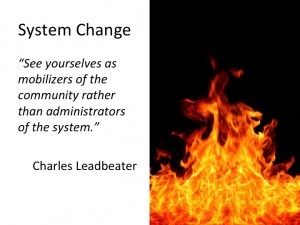 Radical social innovation is most successful when it is a movement connected to a committed community that is driven by a compelling vision. Think of yourselves as a movement and not a system. We are the mobilizers of that community. Who is leading this transformation? You are. Our movement will be educators in the field that are engaged in shifting their pedagogy and collaborating with other educators in this pursuit.
Radical social innovation is most successful when it is a movement connected to a committed community that is driven by a compelling vision. Think of yourselves as a movement and not a system. We are the mobilizers of that community. Who is leading this transformation? You are. Our movement will be educators in the field that are engaged in shifting their pedagogy and collaborating with other educators in this pursuit.
I started by telling you the story of my own children and my dream to have a system that engages them deeply in their learning. I want to transform education. That is my dream. I am not waiting for the Ministry of Education to tell me what to do. I am not waiting for the politicians to tell me what to do. I am not waiting for the public or private business to tell me what to do. Nor should you.
We know what students need. We know how to shift our practice and schooling to engage the learners. Where does that change happen? With you, the educators in the field. It happens one classroom, one school at a time.
Think about it. When we change, others notice. Our circle of influence pays attention and there is a ripple effect. Others join in. There is power in being in the classroom. There is power in your hands. This is about creating a radical social movement for change. You are the change.
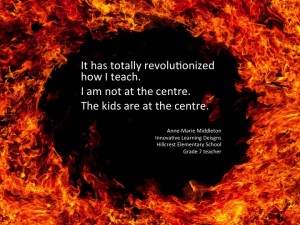 I want to transform education. What do you want to do? Where can you transform the learning of your students? Where do you need to transform your own learning? You create the story. What do you want that story to be?
I want to transform education. What do you want to do? Where can you transform the learning of your students? Where do you need to transform your own learning? You create the story. What do you want that story to be?
Let’s transform education together. Because it matters. Because my children matter. Because your children matter. And because all learners matter.They deserve the best that we can do.
Let’s make it happen.
Postscript: Thank you to all those teachers who are doing the real transformative work in their classrooms with their students each and every day.

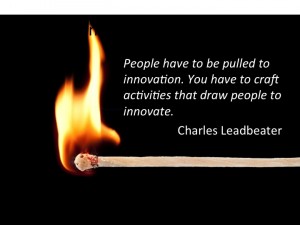

I applaud your vision and your ability to encourage and support the visionaries who work with our children. Most of all, I applaud your courage and willingness to continually put yourself out there, sharing your dreams and your heart. It is not easy to be a transformational leader, but it is so worth it. Thanks for all you do, and thanks for sharing the story!
You continue to inspire me as a leader, as an educator, and as part of the human family. I was touched by your story, inspired by your vision, and the call to action. I especially applaud your passion as you approach your life’s purpose–to transform education. You make it sound do-able and attainable–one child, one classroom, one school at a time. Doing so takes courage and a belief in doing what is right for children in schools. Some parents fear change, the unknown, and fear when learning looks different. How can we go wrong if we inspire children to do their best work? To pursue their passions and learn about what matters to them? Thank you, Elisa, for sharing your vision, your story, and most of all, for leading the way by example.